Over 39 million Americans deal with migraines, and many are searching for natural ways to manage their pain beyond just popping pills.
A growing body of research shows that yoga can be a powerful ally in reducing both migraine frequency and intensity. A 2020 study published in the Journal of General Internal Medicine found that participants who practiced yoga experienced a 48% reduction in migraine frequency after just 12 weeks. Another clinical trial showed that combining yoga with conventional treatment reduced headache intensity by up to 60% compared to medication alone.
This isn’t about becoming a pretzel or standing on your head. The routine I’m sharing with you is gentle, accessible, and takes just 40-45 minutes. It combines six therapeutic poses with specific breathing techniques that studies show can calm your nervous system and release tension in those key migraine trigger spots – your neck, shoulders, and upper back.
The Science-Backed 6-Pose Sequence for Migraine Relief (28-30 minutes)
This sequence focuses on releasing tension in common migraine trigger areas. Each pose is designed to be gentle and soothing – perfect for sensitive days. Remember, this routine works best as an add-on to your usual medical care, not a replacement.
1. Child’s Pose (Balasana) for Deep Relaxation (2–3 min)
Start here to signal to your body that it’s time to slow down and find some peace.
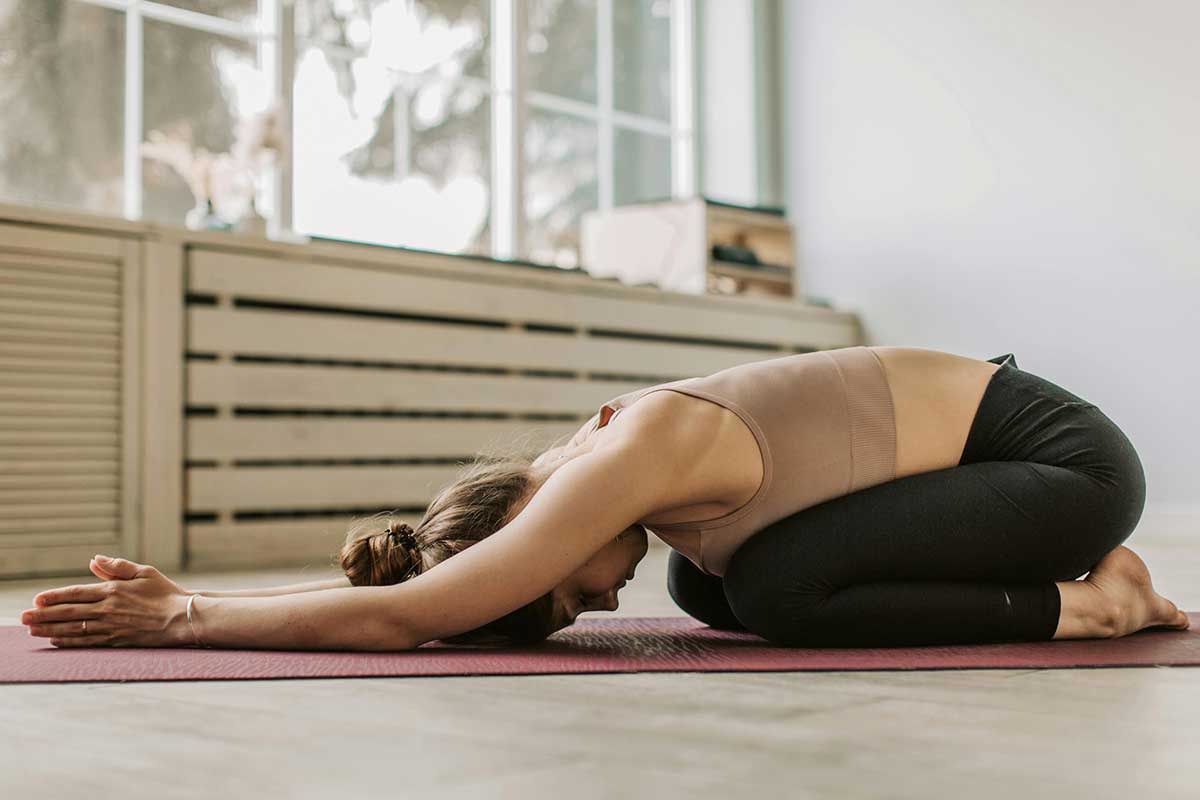
How to do it:
- Come to your hands and knees
- Spread your knees wide, keeping your big toes touching
- Sit back toward your heels
- Rest your forehead on a yoga block or pillow
- Let your arms relax alongside your body
Why it works for migraines:
Child’s pose gently stretches your hips and lower back while calming your brain. The forward fold position naturally lowers your blood pressure and helps relieve stress. Focus on breathing slowly through your nose and let your jaw go soft – tension here often travels straight up to your temples.
Modification for sensitive days:
If kneeling is uncomfortable, try sitting in a chair and folding forward over a pillow on your lap.
2. Cat-Cow (Marjaryasana–Bitilasana) to Gently Mobilize the Spine (2 min)
This gentle movement helps release the stiffness that builds up from hunching over desks and phones.
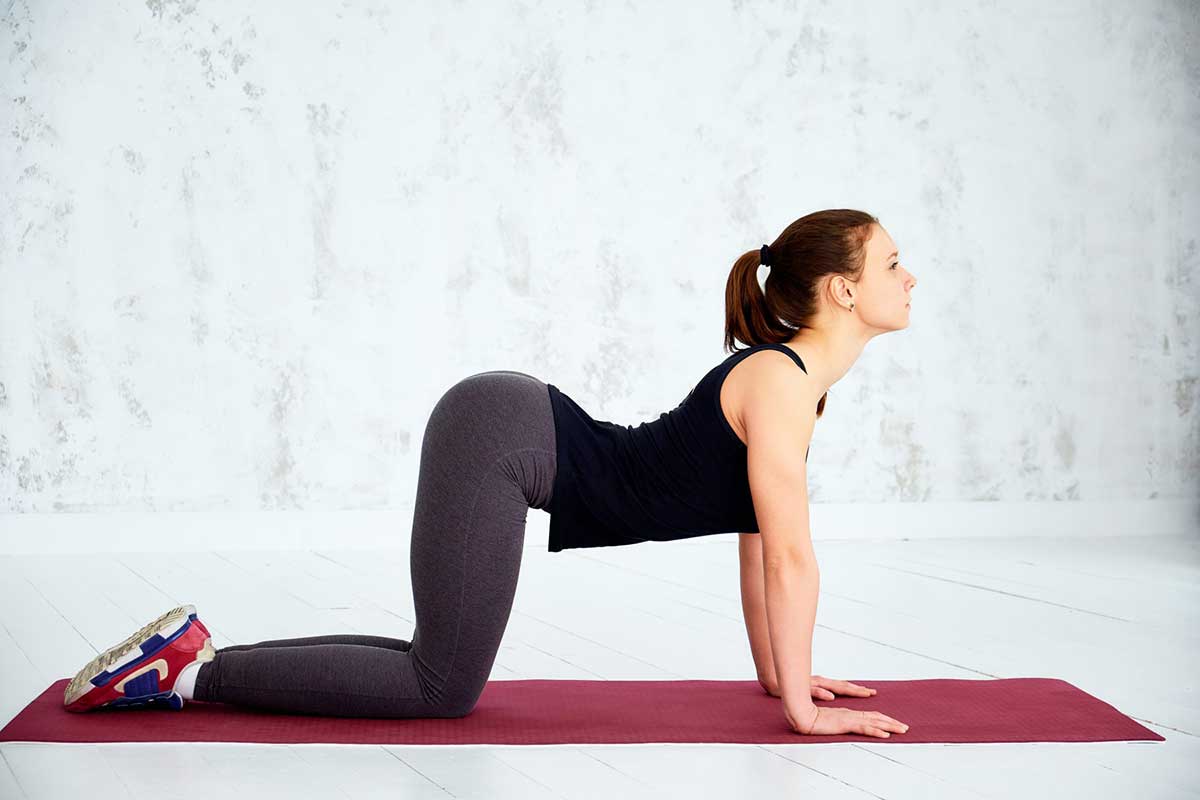
How to do it:
- Start on hands and knees with wrists under shoulders
- Inhale, gently arch your back and lift your chest (Cow)
- Exhale, round your spine like a cat
- Keep movements small and your neck neutral
- Repeat for 6-8 slow cycles
Why it works for migraines:
When your upper back and neck are stiff, it creates a chain reaction of tension that can trigger headaches. These gentle spinal movements improve flexibility and increase blood flow to tight muscles. Think of it as giving your spine a mini massage.
3. Thread the Needle (Parsva Balasana) for Neck and Shoulder Release (1–2 min/side)
This pose targets those stubborn knots between your shoulder blades that love to contribute to head pain.
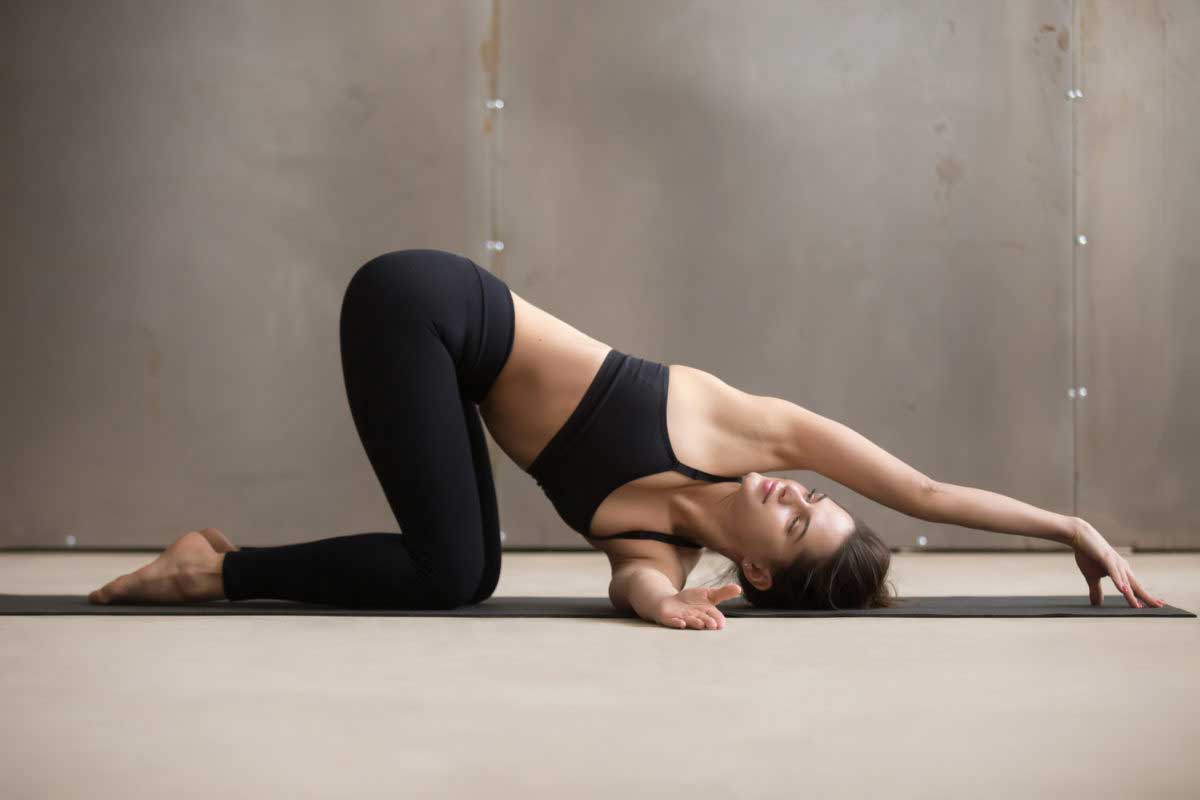
How to do it:
- Start on hands and knees
- Slide your right arm under your left arm
- Rest your right shoulder and temple on the mat (use a block if needed)
- Keep your left hand planted for support
- Breathe deeply and repeat on the other side
Why it works for migraines:
Thread the needle gives you a gentle twist that releases tension in your upper back and neck. Many people carry stress in this area, and when these muscles stay tight, they can refer pain directly to your head. This pose helps break that cycle.
4. Sphinx or Low Cobra (Salamba Bhujasana/Bhujasana) for Gentle Front-Body Opening (2–3 min)
Choose Sphinx if you’re feeling sensitive – it’s the gentler option.
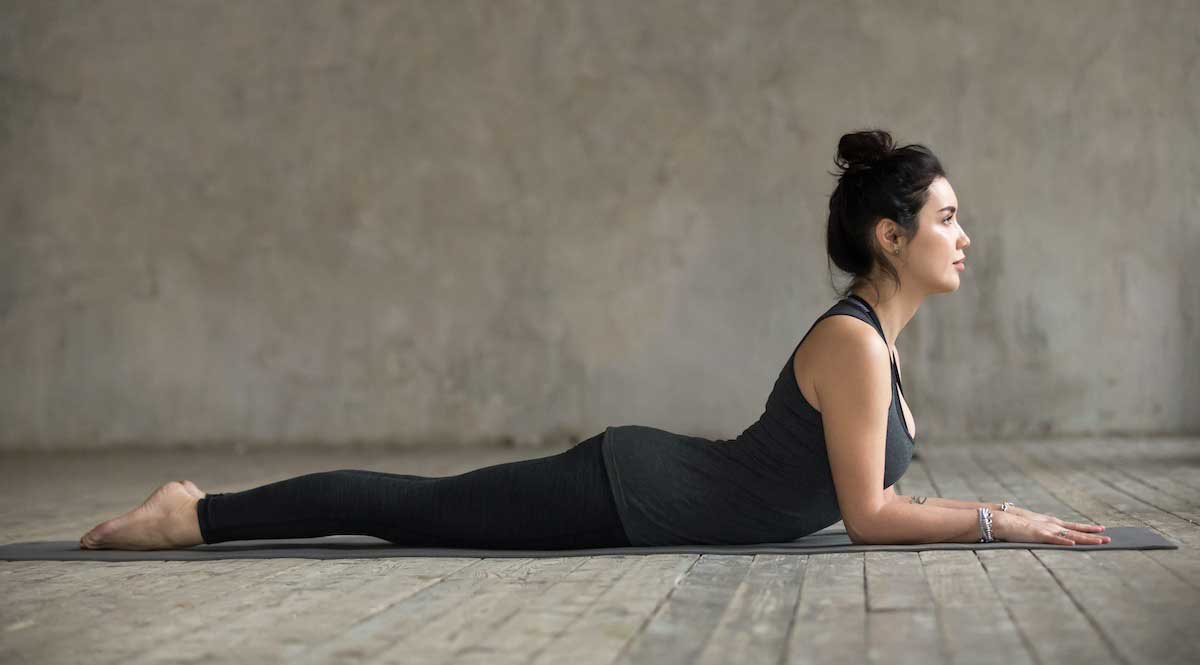
How to do it:
- Lie on your belly with forearms flat on the ground (Sphinx)
- Or place palms flat and lift your chest slightly (Low Cobra)
- Keep your shoulders down and away from your ears
- Avoid pinching your neck back
- Hold Sphinx for 2-3 minutes, or do 6-8 slow Cobra lifts
Why it works for migraines:
Hours of slouching create tight chest muscles and weak upper back muscles. This imbalance puts extra strain on your neck. These gentle backbends help restore better posture and reduce the forward head position that can trigger tension headaches.
5. Supported Bridge (Setu Bandhasana) to Calm the Nervous System (2–3 min)
This restorative version of bridge pose helps shift your body into “rest and digest” mode.
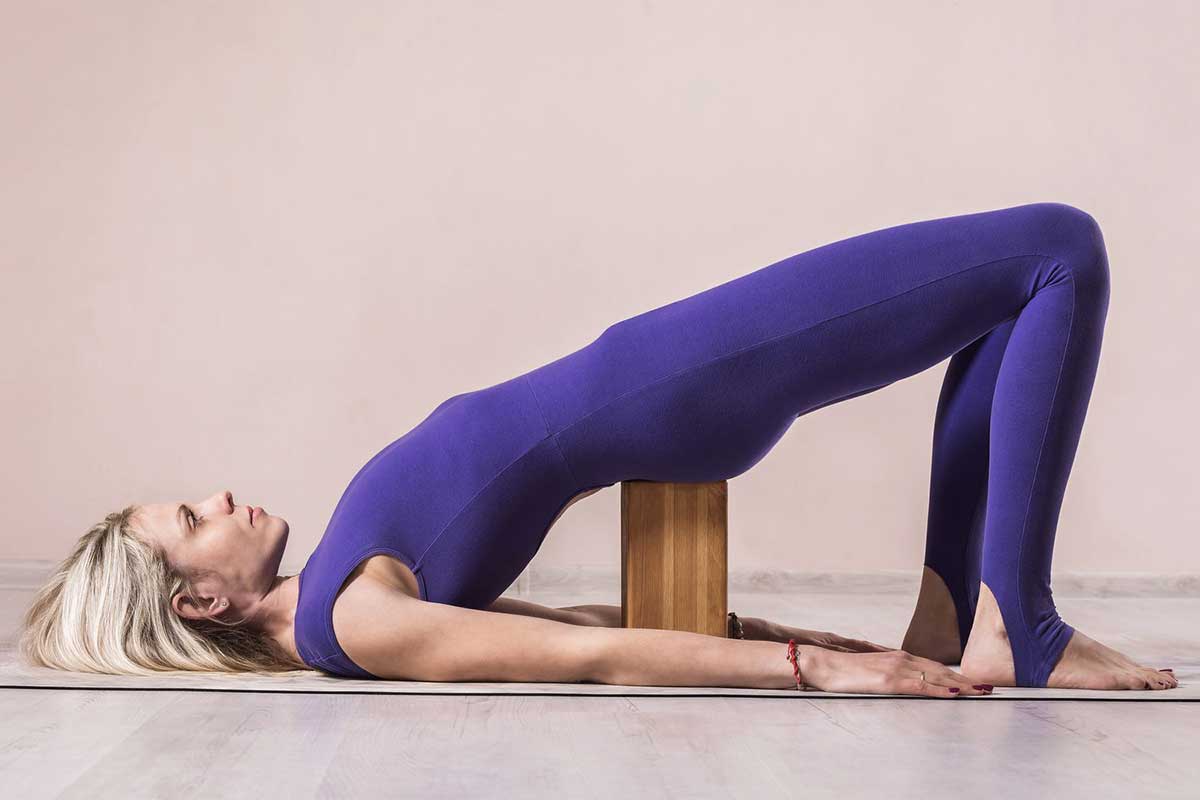
How to do it:
- Lie on your back with knees bent
- Place a yoga block under your sacrum (the bony part at the base of your spine)
- Let your arms rest by your sides
- Focus on making your exhales longer than your inhales
- Skip this pose if it makes symptoms worse
Why it works for migraines:
Supported bridge activates your parasympathetic nervous system – the part responsible for calm and healing. It also improves circulation and can help reduce anxiety, which often goes hand-in-hand with chronic migraines.
6. Gentle Supine Twist (Jathara Parivartanasana) to Release Spinal Tension (1–2 min/side)
End your pose sequence with this soothing twist that helps everything settle.
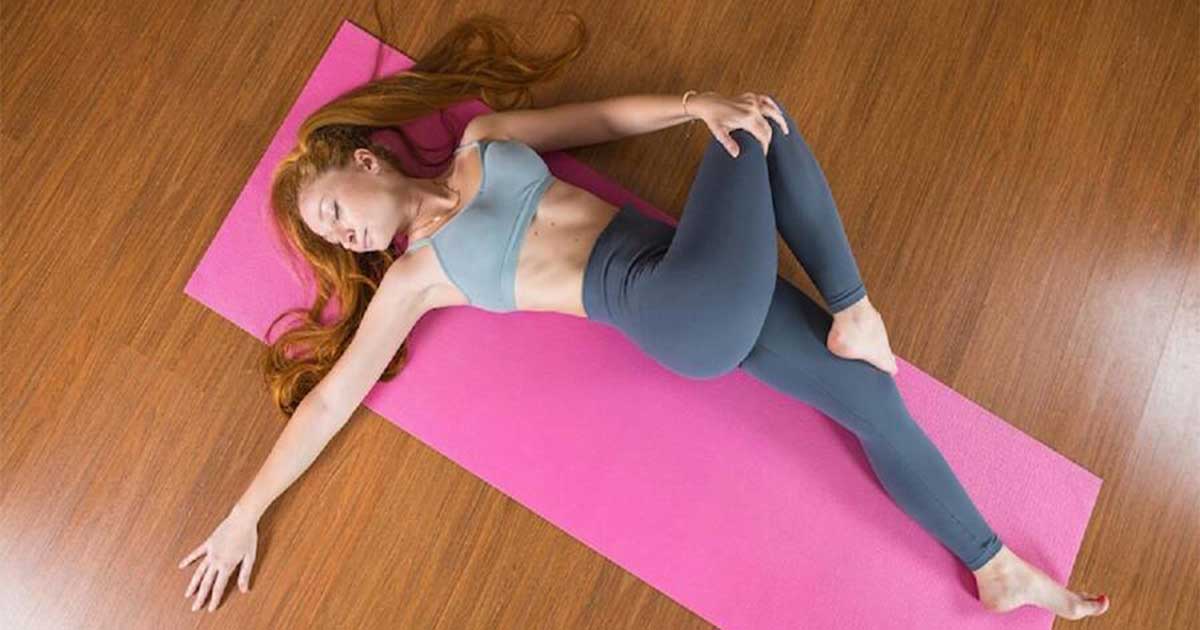
How to do it:
- Lie on your back and bring both knees to your chest
- Lower your knees to the right side
- Keep both shoulders on the ground
- Turn your head gently to the left (don’t force it)
- Repeat on the other side
Why it works for migraines:
This gentle twist helps release any remaining tension in your spine and back muscles. It also aids digestion and can help calm an overactive mind – both helpful when you’re dealing with migraine symptoms.
Adapting Your Practice: A Pro-Tip for High-Symptom Days
Some days, even gentle yoga feels like too much. That’s totally normal and okay. On those high-symptom days, swap out the Supported Bridge for this ultra-gentle alternative.
Legs-on-Chair Pose:
- Lie on your back next to a chair or couch
- Place your calves on the seat with hips and knees at 90 degrees
- Rest your arms by your sides
- Stay here for 5-10 minutes
This pose gives you all the calming benefits of an inversion without putting any pressure on your head or neck. It’s like hitting a reset button for your nervous system.
Understanding Your Migraine Triggers: When to Practice Yoga
Timing your yoga practice can make a big difference in its effectiveness. Here’s when different approaches work best:
| Migraine Phase | Best Yoga Approach | Poses to Focus On | What to Avoid |
|---|---|---|---|
| Before Attack (aura/warning signs) | Gentle preventive practice | Child’s Pose, Gentle twists, Deep breathing | Inversions, intense backbends |
| During Mild Attack | Restorative poses only | Legs-on-Chair, Supported Child’s Pose | Any movement that worsens symptoms |
| Recovery Phase | Full gentle sequence | Complete routine with modifications | Rushing through poses |
| Headache-free Days | Full practice for prevention | Complete 45-minute routine | Skipping practice entirely |
Pro tip: Keep a simple migraine journal noting when you practice yoga and your symptom patterns. Many people find their “sweet spot” is practicing in the late afternoon or early evening.
The Power of Breath: Targeted Breathwork for Migraine Prevention (12-15 minutes)
Here’s where things get really interesting. Studies show that specific breathing techniques can be just as powerful as the physical poses for reducing headache frequency. The key is activating your body’s natural relaxation response.
A. Alternate-Nostril Breathing (Nadi Shodhana) for Balance (5–7 min)
This ancient technique helps balance your nervous system and can be especially helpful during stressful periods.
How to do it:
- Sit comfortably with your spine straight
- Use your right thumb to close your right nostril
- Inhale through your left nostril
- Close your left nostril with your ring finger
- Release your thumb and exhale through your right nostril
- Inhale right, switch, exhale left (that’s one complete round)
- Start with 5 rounds and build up to 10-15
Why it works:
This breathing pattern calms your nervous system and helps balance the left and right sides of your brain. Research suggests it can reduce stress hormones and improve your body’s ability to handle triggers.
B. Humming Breath (Bhramari) for Soothing Vibrations (2–3 min)
The gentle vibrations from this technique can feel like a massage for your head and sinuses.
How to do it:
- Sit comfortably and close your eyes
- Take a normal breath in through your nose
- On the exhale, make a soft humming sound like a bee
- Keep the volume low and gentle
- If it creates pressure, stop and try regular breathing instead
Why it works:
The vibrations from humming can help release tension in your head and face muscles. Some people find it particularly soothing for sinus-related headaches.
Quick Reference: Your Complete 45-Minute Migraine Relief Routine
| Phase | Activity | Duration | Key Benefits |
|---|---|---|---|
| Warm-up | Child’s Pose | 2-3 min | Calms nervous system, releases jaw tension |
| Mobility | Cat-Cow | 2 min | Improves spinal flexibility, releases neck tension |
| Targeted Release | Thread the Needle | 2-4 min total | Releases shoulder blade knots, reduces referred head pain |
| Posture Reset | Sphinx/Low Cobra | 2-3 min | Counteracts forward head posture |
| Nervous System | Supported Bridge | 2-3 min | Activates relaxation response |
| Final Release | Gentle Supine Twist | 2-4 min total | Releases remaining spinal tension |
| Breathwork | Alternate-Nostril Breathing | 5-7 min | Balances nervous system |
| Breathwork | Humming Breath | 2-3 min | Soothes head and sinus tension |
| Integration | Final Rest (Shavasana) | 8-10 min | Deep nervous system reset |
| Total Time | 40-45 min | Complete migraine management routine |
Creating Your Personal Migraine-Relief Environment
Your practice space can enhance the therapeutic benefits. Here’s how to set up for success:
Essential Elements:
- Dim, soft lighting (harsh lights can trigger symptoms)
- Cool, well-ventilated room (overheating is a common trigger)
- Quiet space or gentle instrumental music
- Props within reach (blocks, pillows, blankets)
- Essential oils (optional): lavender or peppermint can be soothing
Quick Setup Checklist:
Yoga Breathing Recipe for Acute Relief
When you feel a migraine coming on, this 10-minute breathing sequence can help:
The 4-7-8 Emergency Calm Technique:
- Inhale through nose for 4 counts
- Hold breath for 7 counts
- Exhale through mouth for 8 counts
- Repeat 4-6 times
- Follow with 5 minutes in Child’s Pose
- Finish with Legs-on-Chair pose
When to use: At first sign of aura, tension, or stress buildup.
C. Final Rest (Shavasana) for Deep Restoration (8–10 min)
This isn’t just lying down – it’s the most important part of your practice.
How to do it:
- Lie on your back with a pillow under your knees
- Cover your eyes with a washcloth or eye pillow
- Let your feet fall open naturally
- Start at the top of your head and mentally scan down your body
- Notice any areas of tension and consciously let them soften
- Stay here for at least 8-10 minutes
Why it’s crucial: Deep relaxation is the secret sauce in every successful migraine study. This is when your body does its real healing work – lowering stress hormones, reducing inflammation, and resetting your nervous system.
Building a Consistent Practice for Lasting Results
Here’s the truth about yoga for migraines: consistency beats intensity every time. You don’t need to be perfect, but you do need to show up regularly.
Frequency and Duration: Aim for 3-5 sessions per week for 8-12 weeks to see the most benefit. This timeline is based on clinical trials where participants saw significant reductions in migraine frequency and intensity.
Tracking Your Progress: What to Expect Week by Week
Week 1-2: Foundation Building
- Focus on learning proper form
- May feel more relaxed after practice
- Don’t expect immediate migraine changes
Week 3-4: Early Adaptations
- Better sleep quality often improves first
- Increased body awareness of tension patterns
- Possible slight reduction in stress-related headaches
Week 5-8: Noticeable Changes
- Many people report fewer tension headaches
- Improved ability to catch migraines early
- Better overall stress management
Week 9-12: Significant Benefits
- Clinical studies show major improvements typically occur here
- 40-60% reduction in migraine frequency for many practitioners
- Improved quality of life scores
Red Flags: When to Stop and Seek Help
While yoga is generally safe, stop your practice and consult your doctor if you experience:
- Sudden, severe headache unlike your usual migraines
- Headache with fever, stiff neck, or vision changes
- Worsening symptoms during or after practice
- New neurological symptoms (weakness, numbness, confusion)
- Any pose that consistently triggers headaches
Common Mistakes That Reduce Effectiveness
| Mistake | Why It Hurts | Better Approach |
|---|---|---|
| Practicing only during migraines | Misses preventive benefits | Regular practice on good days |
| Rushing through poses | Increases tension | Hold poses for recommended time |
| Forcing difficult poses | Can trigger headaches | Use modifications always |
| Skipping the breathing work | Misses major therapeutic benefit | Breathwork is as important as poses |
| Inconsistent practice | Doesn’t build lasting changes | Better to do 20 minutes regularly than 60 minutes occasionally |
Building Your Migraine Management Team
Yoga works best as part of a comprehensive approach:
- Primary care doctor: Overall health monitoring
- Neurologist: Specialized migraine treatment
- Yoga instructor: Proper form and modifications (look for trauma-informed or therapeutic yoga training)
- Massage therapist: Complementary muscle tension release
- Mental health counselor: Stress management and coping strategies
Questions to ask a potential yoga instructor:
- Do you have experience working with chronic pain conditions?
- Can you suggest modifications for sensitive days?
- Are you familiar with trauma-informed yoga practices?
Props Guide: What You Need vs. Household Alternatives
| Yoga Prop | Household Alternative | How to Use | Cost Savings |
|---|---|---|---|
| Yoga Block | Thick hardcover book wrapped in towel | Under forehead in Child’s Pose, support in twists | Save $15-25 |
| Yoga Strap | Belt, necktie, or long towel | Gentle stretching assistance | Save $8-15 |
| Bolster | Firm couch cushion or folded blanket | Support in restorative poses | Save $40-80 |
| Eye Pillow | Washcloth or small towel | Cover eyes during final rest | Save $12-20 |
| Yoga Mat | Thick towel on carpet | Non-slip surface for poses | Save $20-60 |
Symptom Tracking Template
Print this simple tracker to identify patterns and measure progress:
Weekly Migraine & Yoga Log
| Day | Yoga Practice (Y/N) | Duration | Migraine Level (0-10) | Triggers Noticed | Sleep Quality (1-5) |
|---|---|---|---|---|---|
| Mon | |||||
| Tue | |||||
| Wed | |||||
| Thu | |||||
| Fri | |||||
| Sat | |||||
| Sun |
Weekly Notes: What patterns do you notice? Which poses felt most helpful?
Important: Yoga and Migraine Medications
Always consult your doctor before starting yoga if you take migraine medications. Here are general considerations:
| Medication Type | Yoga Considerations | Key Points |
|---|---|---|
| Preventive Meds (like propranolol) | Generally safe to combine | May affect heart rate during practice |
| Acute Treatments (triptans) | Avoid hot yoga styles | Can affect blood pressure |
| Pain Relievers (NSAIDs) | No specific restrictions | Don’t mask pain that indicates you should stop |
| Anti-nausea Meds | May help with practice comfort | Take as prescribed by doctor |
Never use yoga to replace prescribed medications without doctor approval.
Age-Specific Modifications for Safe Practice
Teens (13-18 years)
- Focus on stress management and posture improvement
- Shorter sessions (20-30 minutes) work well
- Emphasize breathing techniques for test anxiety
- Watch for perfectionism that increases tension
Adults (19-64 years)
- Full routine as described works well
- Pay attention to work-related posture issues
- Consider hormone-related triggers (menstrual migraines)
- Balance family/work stress with consistent practice
Seniors (65+ years)
- Use chair modifications for floor poses
- Hold poses for shorter durations
- Focus on gentle movement and breathing
- Be extra cautious with balance poses
15-Minute Morning Prevention Routine
Perfect for busy schedules or travel:
Quick Morning Flow (15 minutes):
- Gentle Neck Rolls (1 minute) – Seated, very slow circles
- Seated Cat-Cow (2 minutes) – In chair, hands on knees
- Shoulder Blade Squeezes (1 minute) – 10 slow repetitions
- Seated Spinal Twist (2 minutes) – 1 minute each side
- 4-7-8 Breathing (3 minutes) – 8-10 cycles
- Seated Forward Fold (2 minutes) – Over crossed legs
- Intention Setting (4 minutes) – Quiet reflection
Best used: Every morning to start your day with less tension.
5-Minute Office Desk Sequence
When you feel tension building at work:
Desk Break Flow:
- Seated Mountain Pose (30 seconds) – Straighten spine, breathe deeply
- Neck Side Bends (1 minute) – Ear toward shoulder, 30 seconds each side
- Seated Spinal Twist (1 minute) – Hold chair back, 30 seconds each side
- Shoulder Rolls (30 seconds) – 5 backward rolls, 5 forward rolls
- Eye Rest (2 minutes) – Palms over closed eyes, breathe slowly
Set phone reminders to do this every 2-3 hours during work.
Partner-Assisted Poses for Extra Support
Sometimes having help makes all the difference:
Supported Child’s Pose with Partner:
- You: In Child’s Pose
- Partner: Gently places warm hands on your lower back
- Duration: 3-5 minutes
- Benefits: Extra grounding and warmth
Partner-Assisted Neck Release:
- You: Lying on back
- Partner: Cradles your head, very gently lifts and turns
- Duration: 1-2 minutes each direction
- Benefits: Deeper neck muscle release
Back-to-Back Breathing:
- Both: Sit back-to-back, legs comfortable
- Together: Match breathing rhythms for 5-10 minutes
- Benefits: Calming shared energy, accountability
Seasonal Adjustments for Weather-Triggered Migraines
Weather changes affect many migraine sufferers. Adapt your practice:
Spring/Fall (Barometric Pressure Changes)
- Practice indoors with stable temperature
- Add extra breathing work during weather fronts
- Focus on balancing poses for inner stability
- Track weather patterns with your migraines
Summer (Heat/Humidity Triggers)
- Practice early morning or evening
- Use fan or air conditioning
- Shorten active poses, extend rest periods
- Keep cool washcloths nearby
Winter (Cold/Dry Air)
- Warm up room before practice
- Use humidifier if air is dry
- Focus on warming poses like gentle backbends
- Layer clothing you can remove as needed
Creating Your Long-Term Success Plan
Month 1: Foundation
- Learn basic poses with proper form
- Establish 3x/week schedule
- Start symptom tracking
- Set up practice space
Month 2: Consistency
- Add breathing techniques
- Increase to 4x/week if feeling good
- Notice early patterns in tracking
- Connect with instructor or online community
Month 3: Integration
- Full routine becomes familiar
- Use emergency techniques during stressful times
- Evaluate medication needs with doctor
- Celebrate small victories
Month 4+: Maintenance
- Adjust routine based on what works best
- Help others learn about yoga for migraines
- Continue tracking major patterns
- Consider advanced workshops or retreats
Conclusion
Your path to fewer, less intense migraines starts with that first gentle pose. Be patient with yourself, stay consistent, and remember that small daily actions create big changes over time. Your future self will thank you for starting today.
Listen to Your Body: Some days you’ll feel energized and want to hold poses longer. Other days, you might only make it through the breathing exercises. Both are perfectly fine. The goal is to create a sustainable practice that supports your healing, not adds stress to your life.
Your migraines didn’t develop overnight, and they won’t disappear overnight either. But with patience and consistency, this gentle practice can become a powerful tool in your migraine management toolkit. Give your body time to respond, be kind to yourself on the tough days, and celebrate the small victories along the way.
Remember, this practice works best alongside your regular medical care. Always check with your healthcare provider before starting any new exercise routine, especially if you have severe or changing headache patterns.
FAQs
Can yoga completely cure my migraines?
Yoga is a powerful management tool, not a cure. Most people see significant improvement but may still need other treatments.
What if I can’t do a pose due to pain?
Always listen to your body. Every pose has modifications or alternatives. Never push through pain.
Should I practice during a severe migraine?
No. Rest in a dark, quiet room. Try gentle breathing only if it doesn’t worsen symptoms.
How quickly will I see results?
Some people feel more relaxed immediately, but significant migraine reduction typically takes 6-12 weeks of consistent practice.
Is hot yoga good for migraines?
Usually not. Heat can trigger migraines in many people. Stick to room temperature or slightly cool environments.


